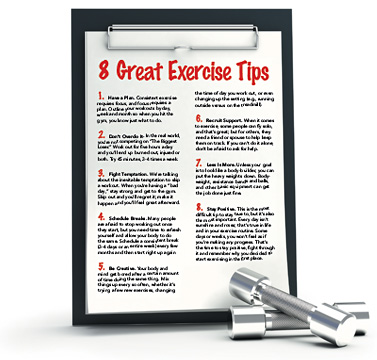
For those who have been away from the gym for a while, getting back into exercising can be difficult. If you've been unable to exercise, you may not be sure where to begin. You may have been too busy or had other responsibilities that have prevented you from getting into shape. This means that you need to take it slow and work your way up gradually. It is important to work on mobility and re-building your basics. Eventually, you should increase the intensity and volume of your workouts. By following these tips, you'll be able to structure your training schedule and return to a fit and healthy lifestyle.
Jumping into high-intensity, interval training (HIIT) is the most common error people make when they start a new exercise regimen. This type of exercise can be very demanding, so you need to make sure you are in good shape. While you might be enthusiastic to do HIIT, it is important that you start slowly and build up to the intensity. You can start moderate activity if your fitness level is not yet established.

It's important to find a buddy for your workouts. A virtual buddy can help you stay motivated and consistent. Alternatively, find a friend who is also interested in getting back into working out. By being accountable to one another, you will be more likely be consistent. It will be easier to stay motivated if you have someone to workout with. You need to choose someone who will help you get back on track with your fitness goals.
Before you start your first workout, you should consult your doctor. A doctor's recommendation will make your mind feel at ease and increase your confidence about your abilities. If you feel like working out is too hard, you can decrease the intensity and time spent exercising. Your body will be used to it. Start small and work your way up. So you can keep active and increase your strength and endurance.
Once you are back in a routine, you need to ensure your diet is as healthy and balanced as possible. You should ensure that you eat whole foods and get enough protein. After a break, you will need a restart to your meal prep. It doesn't matter if you like baking or cooking, it is important to keep your body happy. You should be active again if your body has been off for a while.

You should take at most two weeks off before starting your training. You'll need to have a plan before you begin. Start by working out for as much time as you can. It is important to keep your intensity down by going to the gym. One example is that you may only need to do a couple of 30-minute sessions each week. To keep your routine current, you can even add one extra day to your weekly schedule.
FAQ
What causes weight loss as we age?
How can you find out if your weight has changed?
Weight loss occurs when there is less fat than muscle mass. This means that the amount of calories consumed must exceed the amount of energy used daily. Activity levels are the most common reason for weight loss. Others include pregnancy, hormonal imbalances or certain medications. If there is more body fat than muscle mass, then weight gain can occur. It occurs when people consume more calories per day than they need. Overeating, increased physical activity and hormonal changes are all common reasons.
Our bodies lose weight because we eat fewer calories than we burn. The main reason we lose weight is because we exercise more often. This increases our metabolism rate and burns more calories each day. But, this does not mean that we will be thinner. It is important to know if we are losing weight or gaining muscle. If we are burning more calories than what we eat, then we will lose weight. But if you consume more calories than you burn, you're actually storing them for fat.
As we get older, our movement speed slows down and so we move less. We also tend to eat less food than we did when we were younger. Therefore, we tend to put on weight. However, our muscle mass is more important than we realize and makes us appear larger.
It's not possible to measure how much weight your body has lost without weighing yourself every week. There are many different ways to measure your weight. You can check your waist size, your hips, your thighs, your arms, etc. Some prefer to use the bathroom scales, others prefer to use tape measures.
Track your progress by measuring your waistline and weighing yourself every week. You can also take photographs of yourself every few years to track how far your progress has been.
You can also check your height online to find out how many pounds you have. If you're tall at 5'10", and weigh 180lbs, your weight would be 180.
How do you measure body fat?
A Body Fat Analyzer will give you the most accurate measurement of body fat. These devices are used for measuring the percentage of body fat in people who want to lose weight.
How can you live your best life every day?
Find out what makes YOU happy. This is the first step in living a life that you love. Once you have a clear understanding of what makes you happy you can go backwards. You can also inquire about the lives of others.
You can also read books by Wayne Dyer, such as "How to Live Your Best Life". He discusses happiness and fulfillment in every aspect of our lives.
What can you do for your immune system to improve?
There are trillions upon trillions on cells in the human body. Each cell is responsible for creating organs and tissues with specific functions. If one cell dies, a new cell takes its place. Cells also communicate with each other using chemical signals called hormones. Hormones control all bodily functions, including growth, development, metabolism, immunity and immune system.
Hormones can be described as chemicals produced by glands in the body. They travel through bloodstreams and act as messengers that control the function of our bodies. Some hormones come from the body and others from outside.
Hormone production occurs when hormone-producing cells release their contents into your bloodstream. Once hormones are released, they move through the body to reach their target organ. Sometimes hormones stay active for only a short time. Others hormones remain active longer and still have an influence on the body's functioning long after they leave bloodstream.
Some hormones can be produced in large amounts. Others are produced in small amounts.
Some hormones only are produced during certain periods of life. Estrogen is one example. It's produced in puberty, pregnancy and menopause. Estrogen aids women in developing breasts, maintaining bone density and preventing osteoporosis. It also promotes hair growth and keeps skin smooth and soft.
How do you get enough vitamins?
Most of your daily vitamin requirements can be met by diet alone. Supplements are available if you are deficient. A multivitamin can contain all the vitamins that you need. You can also purchase individual vitamins at your local drugstore.
Talk to your doctor about the best foods for vitamins if you're concerned about not getting enough nutrients. Dark green leafy vegetables like spinach, broccoli and kale, as well as turnip greens and mustard greens such as turnip and mustard greens and bok choy, are rich in vitamins K & E.
If you are not sure how much vitamin you should be consuming, ask your doctor. Your medical history and current health will help you determine the best dosage.
Statistics
- According to the 2020 Dietary Guidelines for Americans, a balanced diet high in fruits and vegetables, lean protein, low-fat dairy and whole grains is needed for optimal energy. (mayoclinichealthsystem.org)
- Extra virgin olive oil may benefit heart health, as people who consume it have a lower risk for dying from heart attacks and strokes according to some evidence (57Trusted Source (healthline.com)
- nutrients.[17]X Research sourceWhole grains to try include: 100% whole wheat pasta and bread, brown rice, whole grain oats, farro, millet, quinoa, and barley. (wikihow.com)
- In both adults and children, the intake of free sugars should be reduced to less than 10% of total energy intake. (who.int)
External Links
How To
What does "vitamin" actually mean?
Vitamins can be described as organic compounds found in food. Vitamins are essential for our bodies to absorb nutrients from the foods we eat. Vitamins are not made by the body, so they must be obtained through food.
There are two types if vitamins: water soluble, and fat soluble. Water-soluble vitamins dissolve readily in water. Vitamin C,B1(thiamine), B2 (2riboflavin), and B3 (3niacin), as well as vitamin C,B1, B2 (riboflavin), and B3 (niacin), vitamin B6 (pyridoxine), vitamin folic acid (biotin), pantothenic, and choline are examples. Fat soluble vitamins are stored in the liver and fatty tissue. You can find vitamin D, E K, A, beta carotene, and other fat-soluble vitamins.
Vitamins are classified according their biological activity. There are eight main groups of vitamins.
-
A - essential for normal growth and maintenance of health.
-
C - vital for proper nerve function, and energy production.
-
D - necessary for healthy bones and teeth.
-
E - Required for good vision & reproduction
-
K - required for healthy muscles and nerves.
-
P - essential for strong bones, teeth and tendons
-
Q - Aids digestion and iron absorption
-
R - Required for red blood cell production
The recommended daily intake (RDA), of vitamins varies with age, gender and physical condition. RDA values are set by the U.S. Food and Drug Administration (FDA).
For adults aged 19 and older, the RDA for vitamin B is 400 micrograms daily. Because it is essential for the development of the fetus, pregnant women should consume 600 micrograms per daily. Children ages 1-8 require 900 micrograms per day. Children under 1 year old require 700 micrograms daily, while infants over one year old need 500 micrograms every day. This decreases between 9 and 12 months.
Children aged 1-18 years need 800 micrograms daily, while children overweight require 1000 micrograms per days. Children who are severely obese or underweight will need 1200 micrograms each day.
Children 4-8 years old who have anemia must consume 2200 micrograms of Vitamin C daily.
2000 micrograms are required daily for good health in adults over 50. Due to their increased nutrient needs, pregnant and breastfeeding women need 3000 micrograms daily.
Adults over 70 years of age need 1500 micrograms per day since they lose about 10% of their muscle mass each decade.
Women who are pregnant, nursing or breastfeeding need more than the RDA. Pregnant women require 4000 micrograms daily during pregnancy, and 2500 micrograms every day after birth. Breastfeeding mothers require 5000 micrograms daily when breast milk production is occurring.